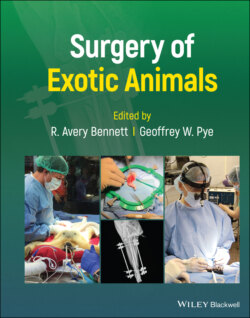Читать книгу Surgery of Exotic Animals - Группа авторов - Страница 92
Annelids
ОглавлениеThe annelids are a large and diverse group of segmented vermiform animals that are divided into three main classes: the Polychaetes, Oligochaetes, and Hirudineans. All are characterized by regular segmentation of the trunk. It is believed this segmentation evolved as a means of burrowing via peristaltic contractions (Ruppert and Barnes 1994). Annelids have a coelomic cavity that is divided into segments by septa. The circulatory, excretory, and nervous systems are also segmented. A cuticle covers the animal and segmented setae occur in nearly all members of the phylum. The mouth is located cranially and the anus caudally with a straight gut between the two openings (Ruppert and Barnes 1994). Certain species such as tropical marine polychaetes like feather duster and Christmas tree worms are important and valuable display animals.
Some polychaetes and oligochaetes have the capacity to regenerate portions of their bodies (Ruppert and Barnes 1994). Park et al. (2013) reports on healing and blastema formation after tail amputation in earthworms. Like coelenterates and cephalopods, this has led to experimental amputations and bisections requiring nothing more than a scalpel or other sharp instrument (Bely and Wray 2001; Zattara and Bely 2011). In nearly every case, the details of the procedure are minimal (e.g. a scalpel was used or amputated with a scalpel). Much of the early research on tissue grafting and rejection was performed on earthworms (Cooper 1968, 1969a,b; Bailey et al. 1971; Cooper and Roch 1986). More recently, earthworms have been used as models for microsurgery training (Figure 4.7) since they resemble mammalian vessels and are superior to synthetic materials (Ramdhian et al. 2011; Leclère et al. 2012, 2013).
Figure 4.7 This series of images shows how earthworms can be a model for vascular surgery training (anastomosis). (a) Clamping the earthworm (Lumbricus sp.), (b) opening the body lumen, (c) two initial sutures, and (d) completed anastomosis.
Source: LeClere et al. 2013.
Salgado et al. (2014) determined that polyglactin 910, among the five suture materials (braided silk, chromic gut, monofilament nylon, polydioxanone, and polyglactin 910) tested in the skin of Lumbricus terrestris, resulted in the most tissue holding security. Moderate tissue reaction was noted to all five suture materials. A study from the human medical literature focused on anchoring the medicinal leech (Hirudo medicinalis) to patients with superficial and deep tissue with braided silk found found no difference in survival among leech groups with deep and superficial braided silk versus control leeches without suture (Davila et al. 2009).
